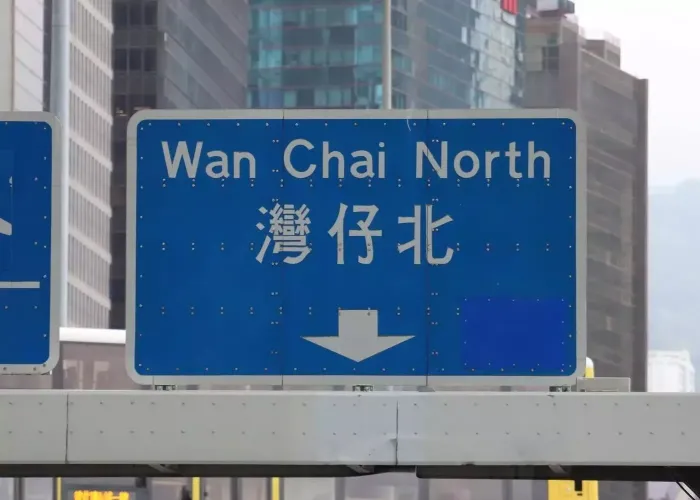What is Prison Gothic? The Former Typeface of Hong Kong's Road Signs Made in Stanley Jail

Gary Yau is a fanatic in road design.
A founding member of the Road Research Institute, a non-profit society that "provides road information and knowledge to the public." Gary has a steadfast commitment to documenting Hong Kong’s labyrinthian transport model.
In 2016, Gary and his team at the Road Research Institute launched the Prison Gothic Revival Program (監獄體重現計劃), a project to record the “prison font” of the hand-made street signs found in Hong Kong and digitise it into a font to use online.
Gary coined the term six years ago for the hand-drawn Chinese letter system for Hong Kong’s traffic signs, as 監獄體 (gaam1 yuk6 tai2), or ‘prison gothic,’ gothic, existing as an alternative typographic term for sans-serif typefaces.
Its peculiar, youthful name comes from the typefaces history, where a flourishing industry existed in one of Hong Kong’s most secure prisons, which created a history worthy of a cult following – Hong Kong’s historic typeface that dominates the city’s road signs.
As per colonial law and now Chinese rulings, adult inmates imprisoned at Hong Kong’s correctional institutions must be meaningfully occupied six days each week, earning anywhere from HK$45 to HK$192 weekly.
In a service worth HK$442 million (2018 figures) to the Hong Kong government, prisoners make office furniture, staff uniforms, metal railings, provide laundry services to the Hospital Authority, laminate books for Hong Kong’s libraries, envelopes for various government departments, and create road signs for city streets and roadways.
At Pak Sha Wan Correctional Institute, informally known as Stanley Prison, where around 500 adult inmates are imprisoned, a team of eighty inmates work in the prison’s two signage rooms. Annually, more than 7000 road signs and 1,500 square meters of signage are produced in the compound – roughly 99% of all Hong Kong’s road signs.
The prison Gothic typeface sees itself in the 1990s as standard practice in Stanley Prison, where road signs were hand made in Pak Sha Wan using hand-cut lettering from stencils. The inaccuracy that came from human error resulted in the characteristic lop-sided, tilted, occasionally wider or smaller font.
“The Prison Gothic uses traditional character form, as well as including variant Chinese characters. These writing styles are different from how Chinese characters are written and shown today,” Gary told The Beat Asia. The ‘prison’ characters have their own flair and curves, foreign to modern Chinese fonts.
Gary describes his connection with Hong Kong’s old handmade typeface as a childhood fascination with road signs encircling his hometown of Yuen Long.
“When I was a child, I learned writing Chinese characters by looking at the road signs. I wrote "元朗" (Yuen Long) in the traditional way. However, my primary school teacher said that is wrong. I was confused why there were "wrong" characters on it, but I just followed my teacher's instruction to write the standard character.”
“In 2010, several road signs in Yuen Long were corrected to a standard writing by patches, since one of the council members thought the “朗” was wrong, which actually is the traditional form. But I can’t memorise how the old writing looks, so I wanted to find out the difference between the old and new characters.”
During Gary’s early childhood, the Prison Gothic typeface turned into a dying breed. Born in 1998, Gary, to his dismay, never lived in a stencil Prison Gothic typeface-era.
Hong Kong saw a seismic shift post-1997 in governmental policy and how authorities ran the city, from restructuring the department, instituting Hong Kong-Chinese laws, and the nitty gritty, such as traffic road sign design and planning.
In 1997, the large Pak Sha Wan prison workshop switched from a hand-cut stencilled street sign production to digital typefaces, predominantly the British sans serif typeface Transport, created in the 1960s in the U.K. for use on British roads and in then-colonial lands.
One-off signs are digitally printed today in the workshop, and traffic signs are mass produced using silkscreen technology. New road signs use a Transport typeface for English and a standard traditional Chinese typeface for the Chinese characters.
No imperfections exist now on Hong Kong’s street signs, which once their forebears were famous for.
“I started this project in 2016, to ‘preserve’ the road signs with the old-style handmade typeface by prisoners,” says Gary.
“The Prison Gothic officially discontinued in 1997 due to the computerisation of the road signs manufactured. Digital fonts replaced them on the new road signs, and there are only about 500 remaining.”
“Since computerisation of general publishing and the introduction of Chinese computer operating systems in the 1990s, people started to use new forms of writing based on the standard typefaces provided by operating systems. The traditional characters are therefore left forgotten; thus, I started this project to preserve the old-style writing by digitising it.”
Recording the street signs is a painstaking process, and involves Gary and his team scouring the city for signs, identifying and dating them, and most importantly, taking photographs for later digitisation.
“We use Google Maps Street View to find where the prison Gothic road signs are located, then we go there to take photos. However, the street views are not all up to date; sometimes the signs were removed before we visited,” Gary complains.
The Road Research Institute hopes to have a full-set digitised and downloadable type face for people to type online, and documented all 500 to 600 signs still existing in Hong kong. For Gary and his team, Prison Gothic is a devotion that for many Hong Kongers goes amiss when travelling around the city.
Subscribe to The Beat's newsletter to receive compelling, curated content straight to your inbox! You can also create an account with us for free to start bookmarking articles for later reading.





































